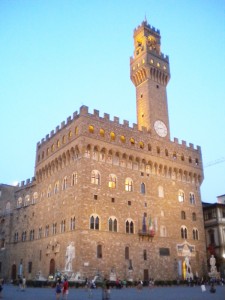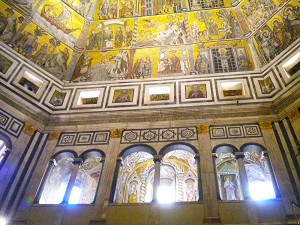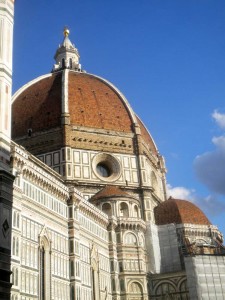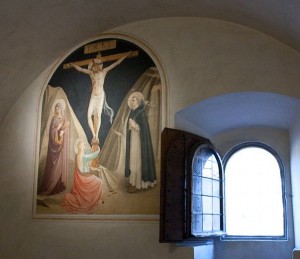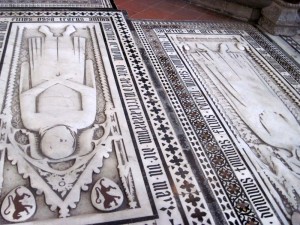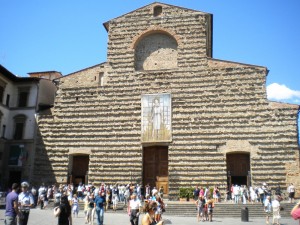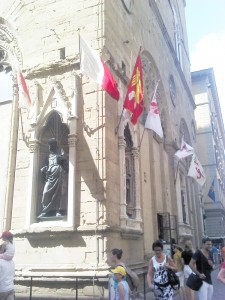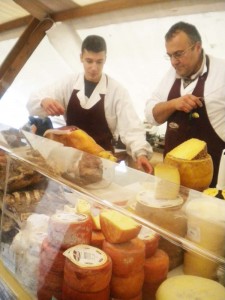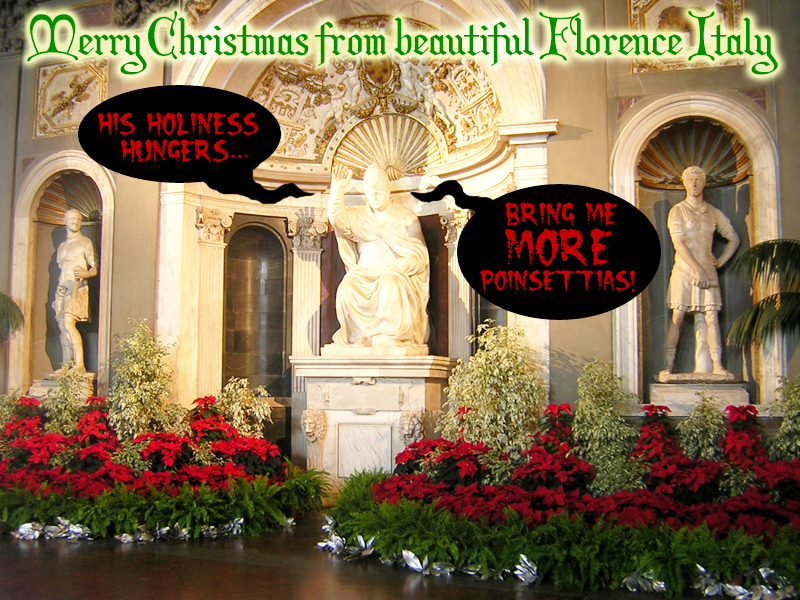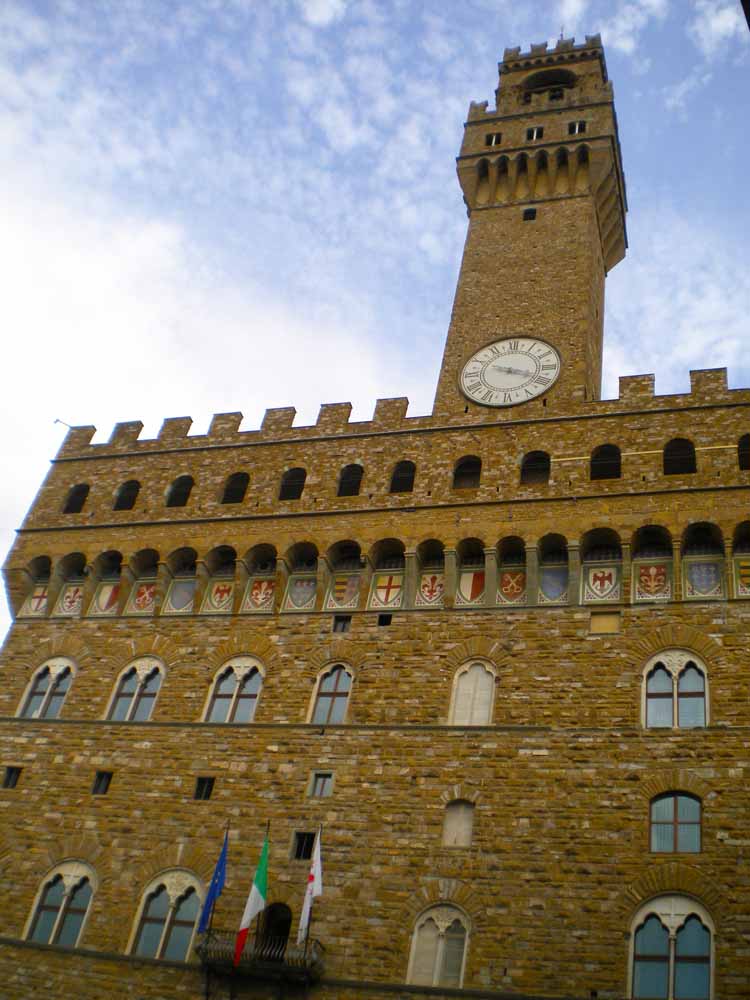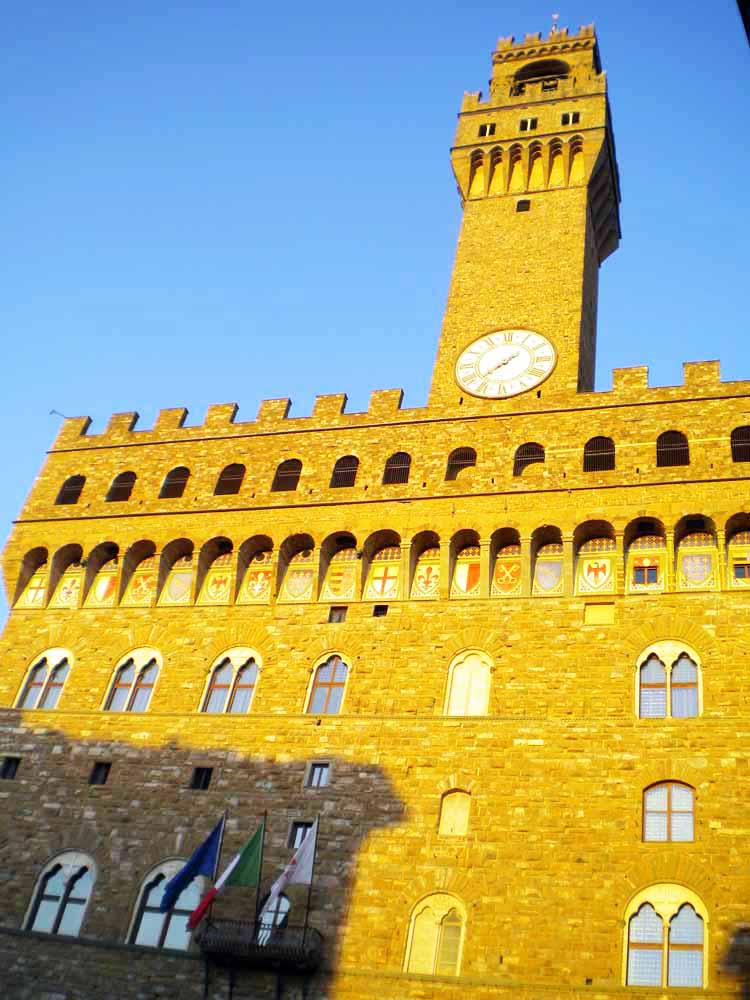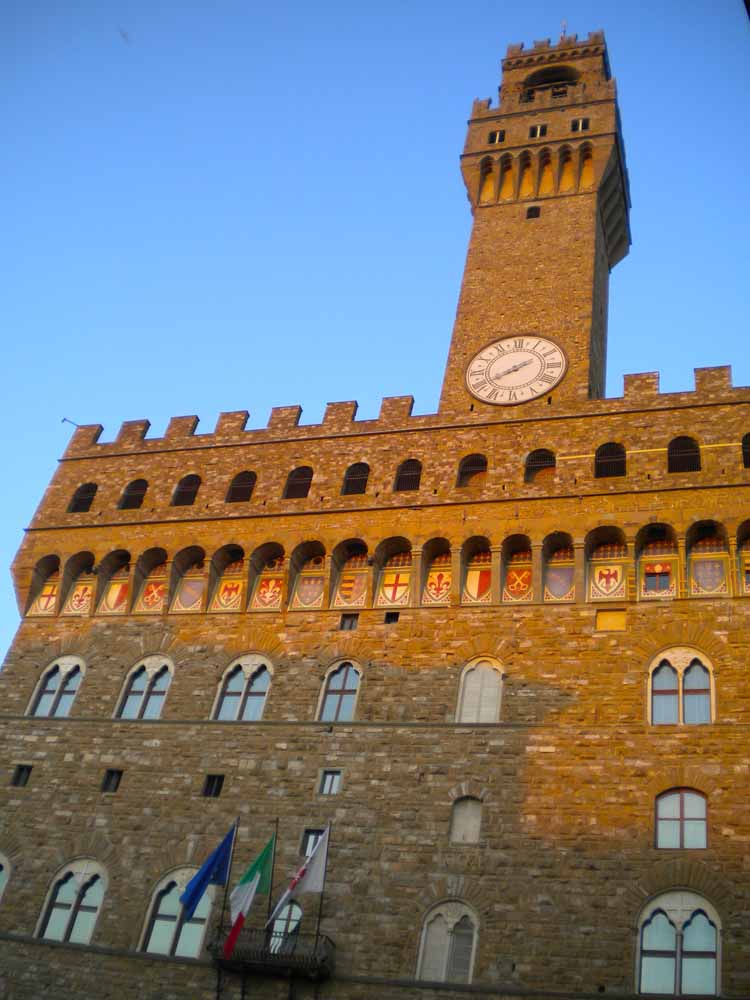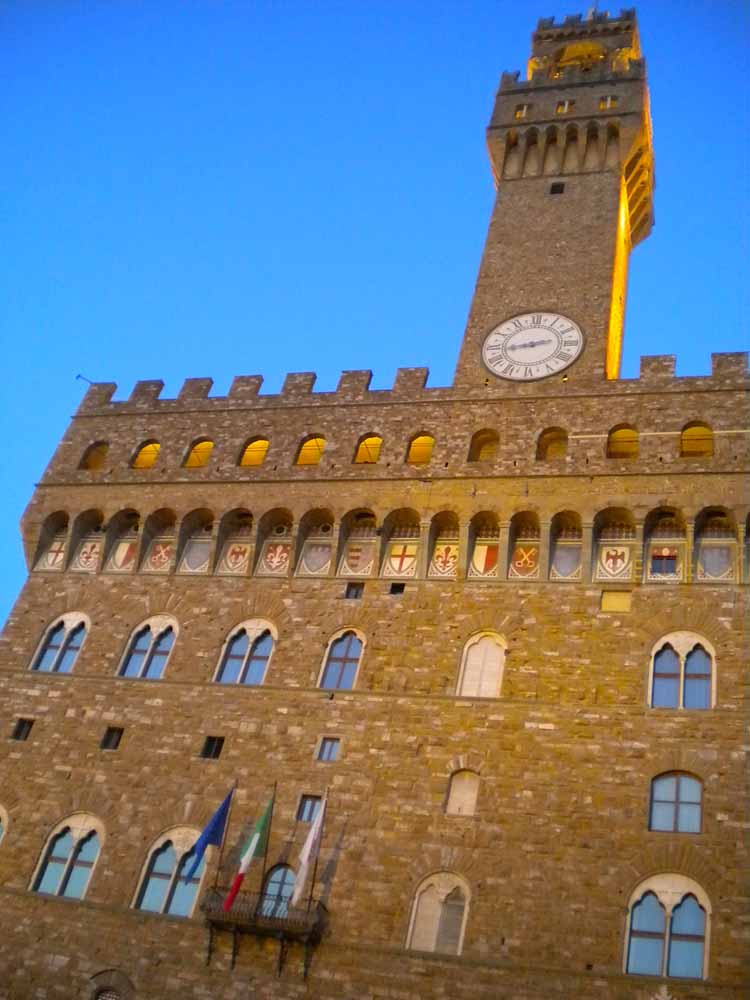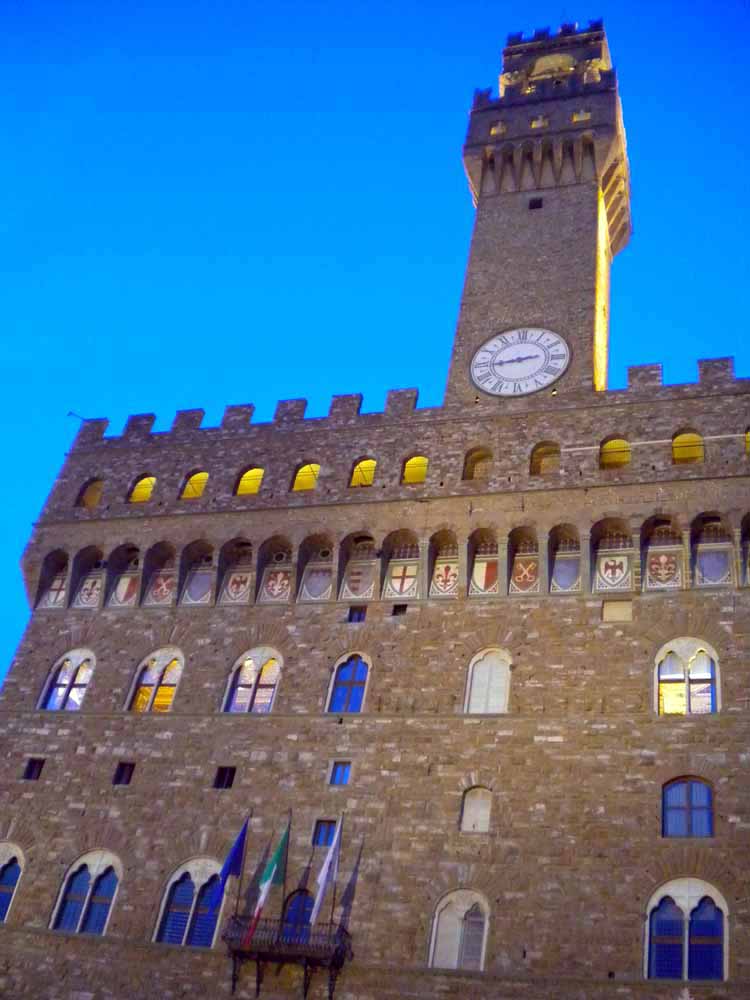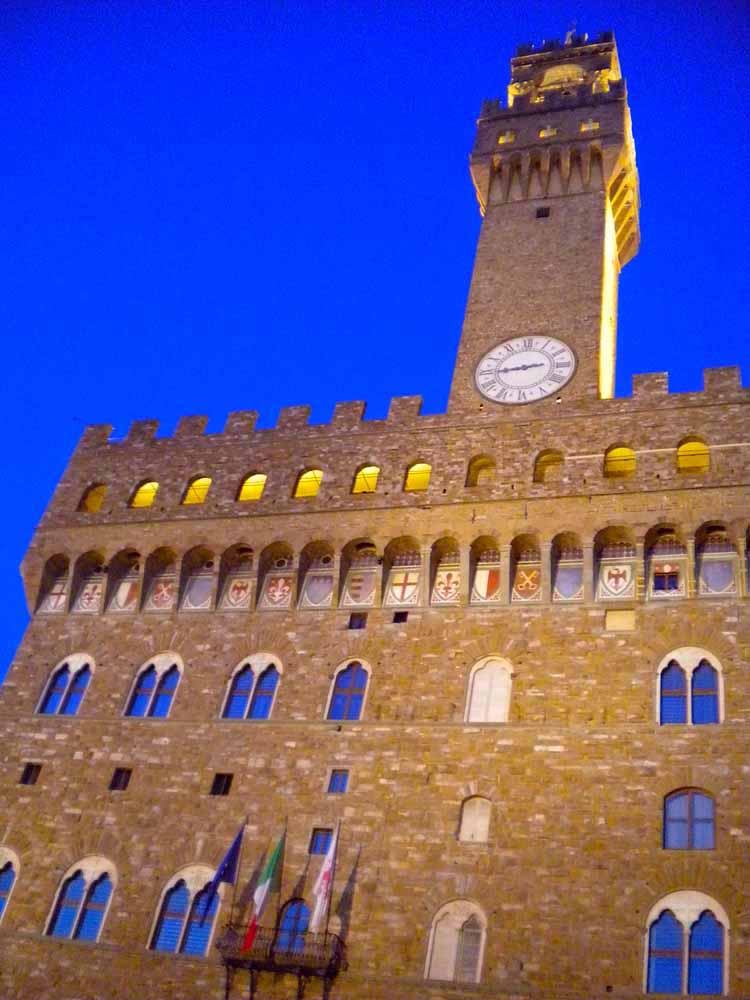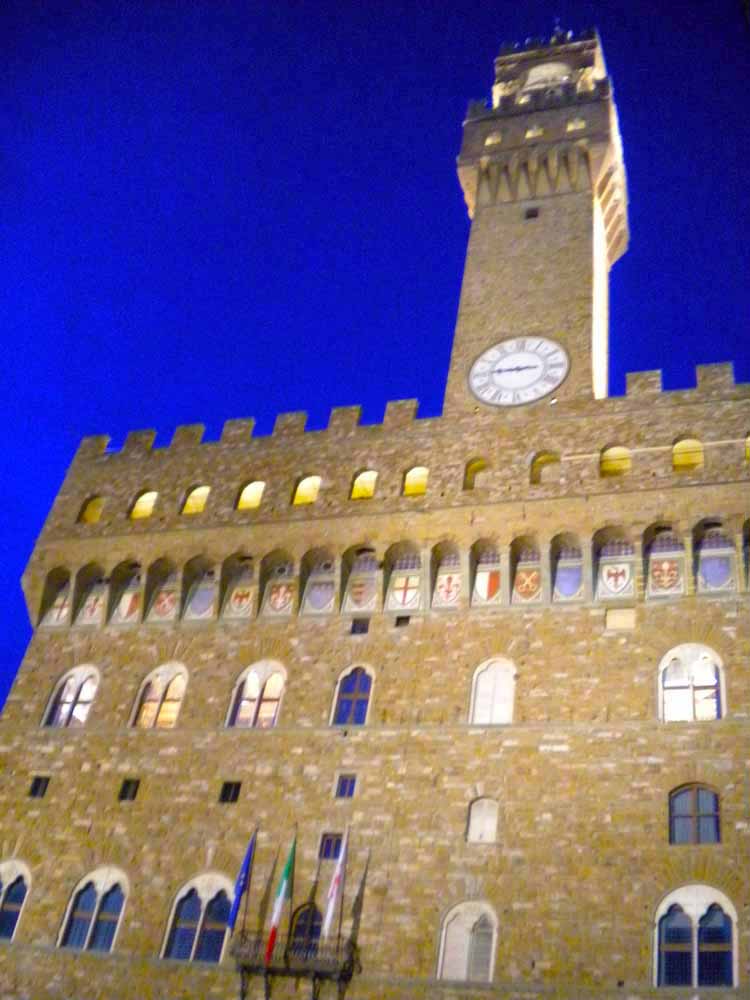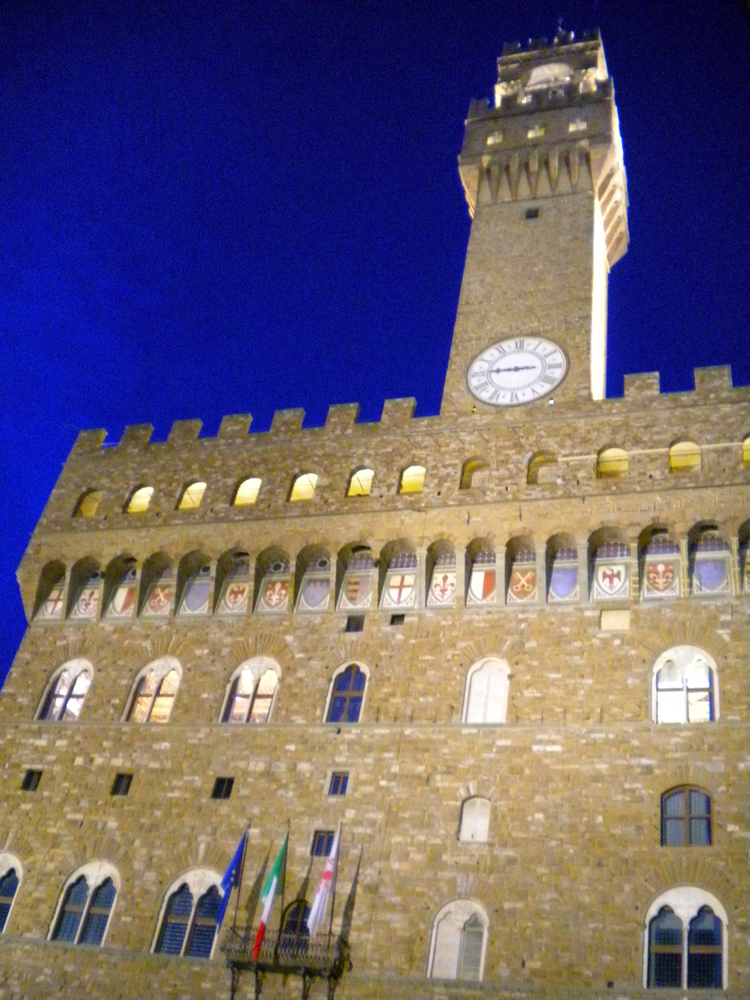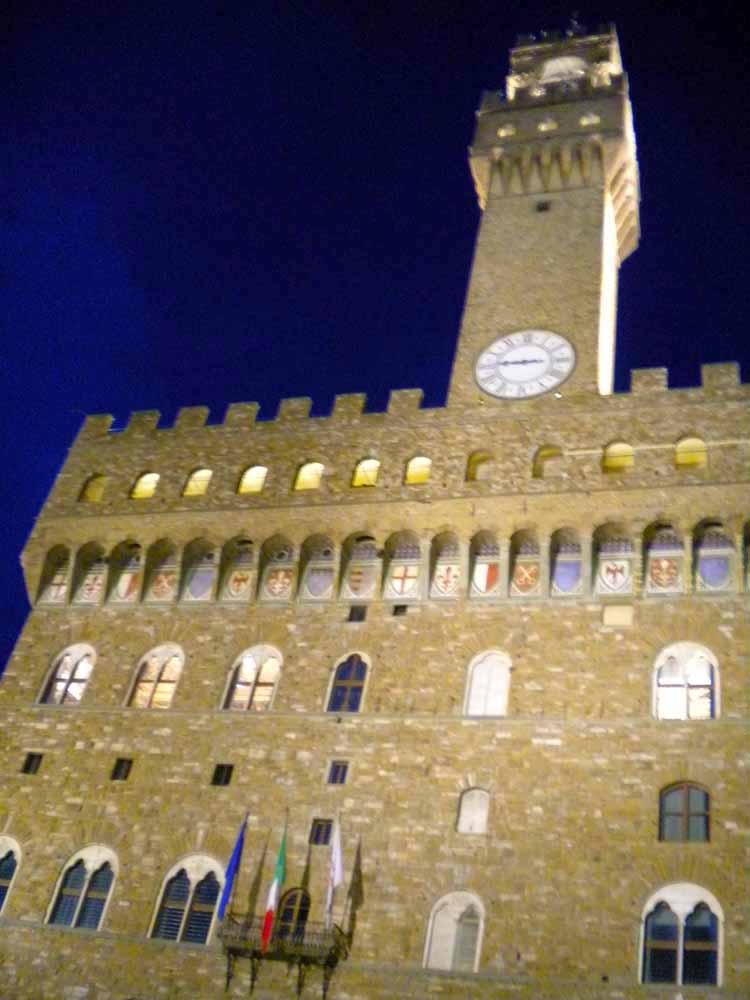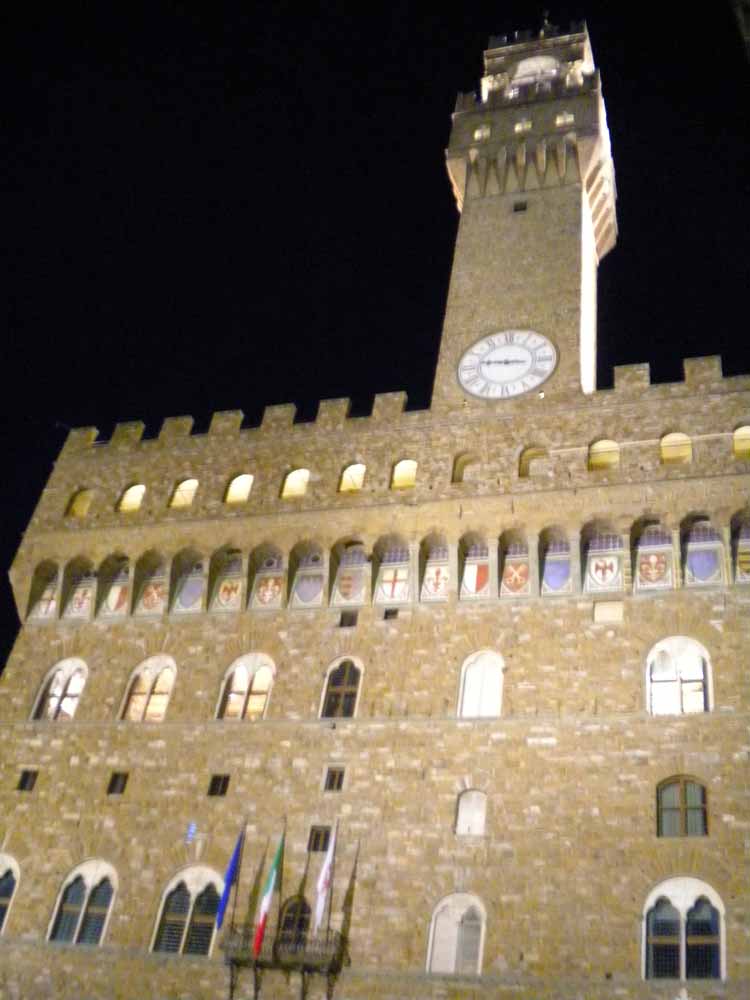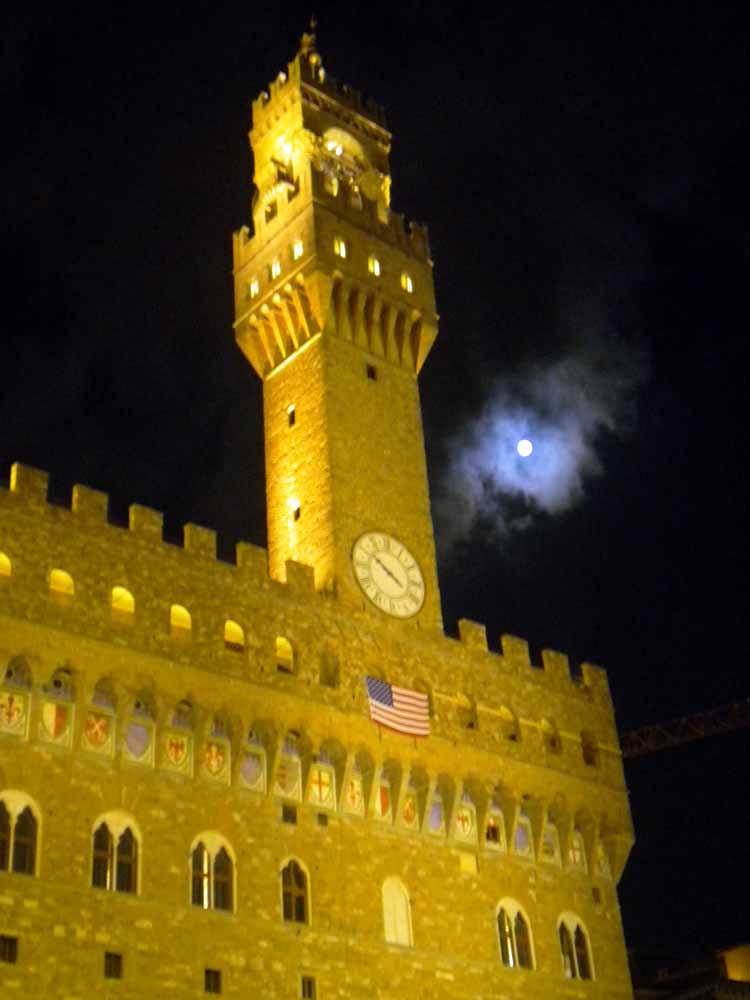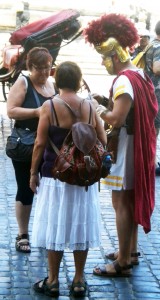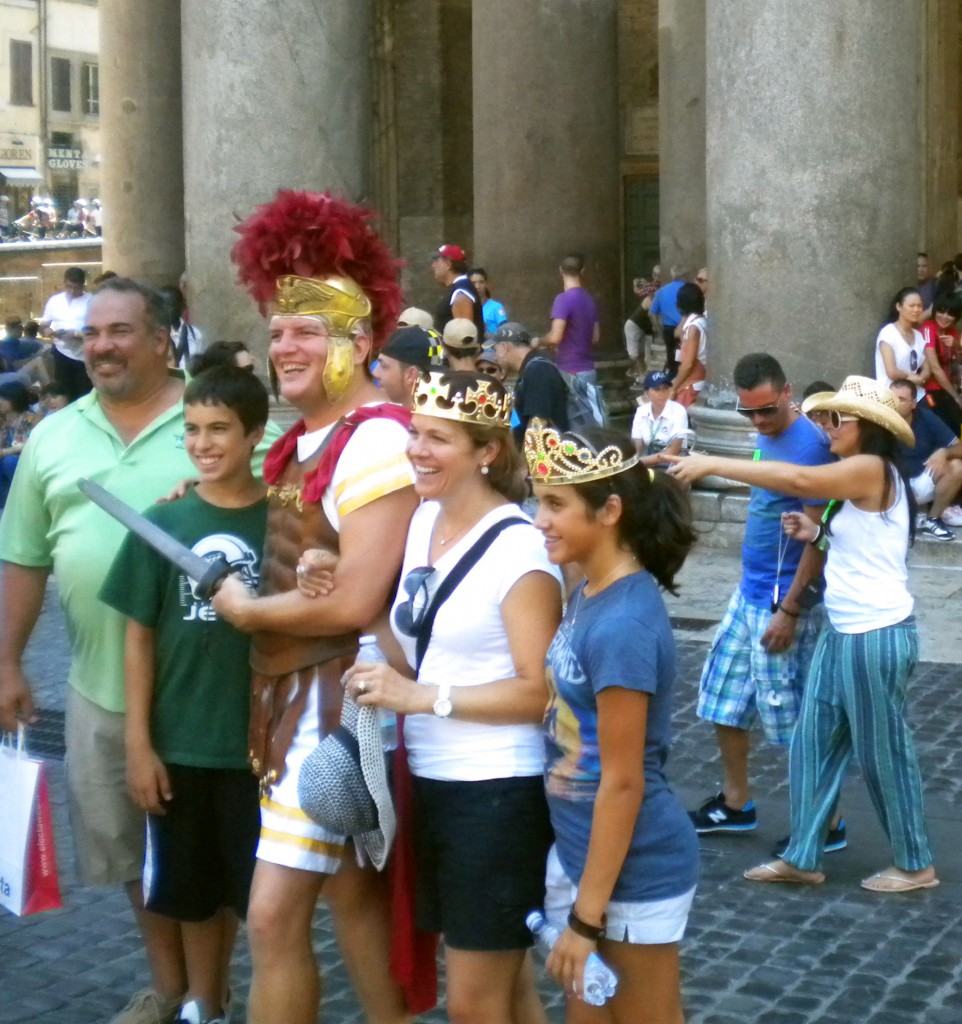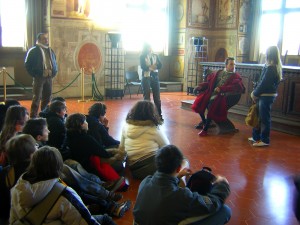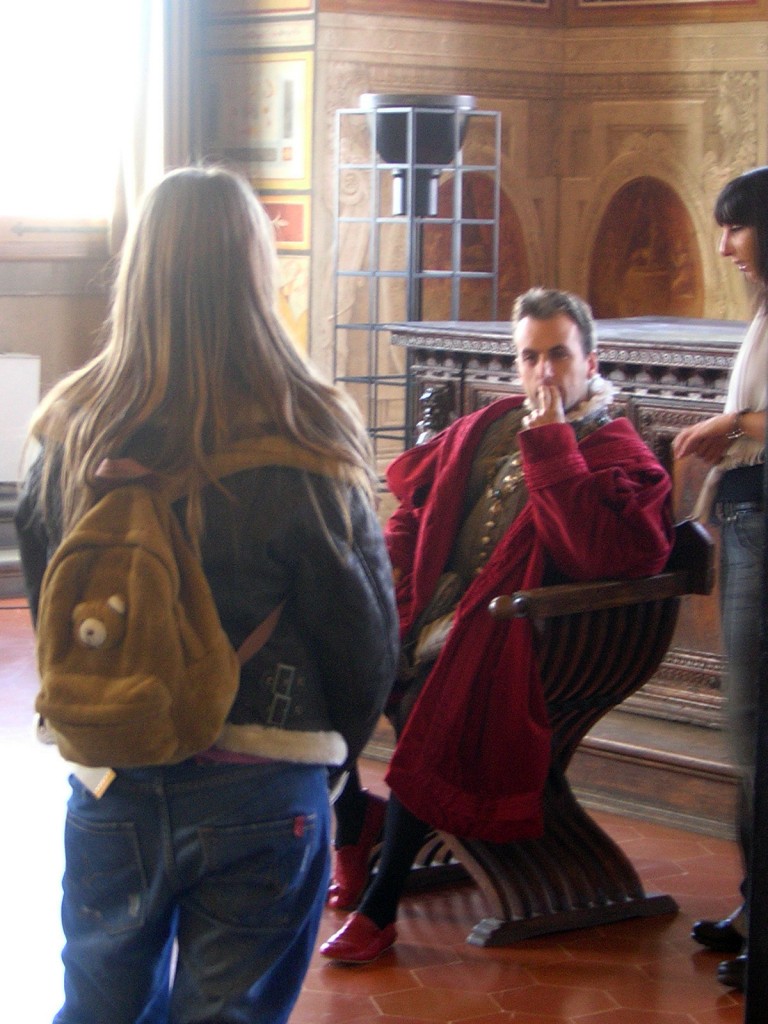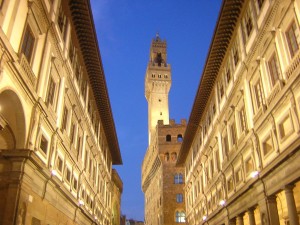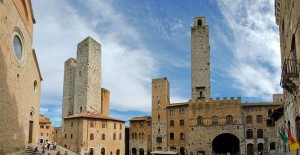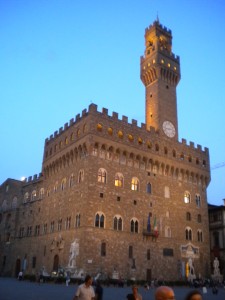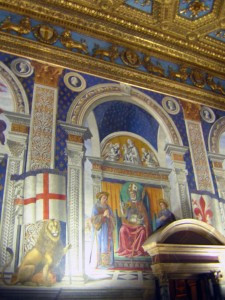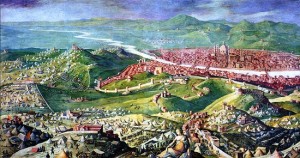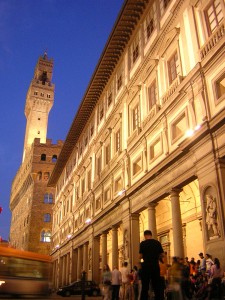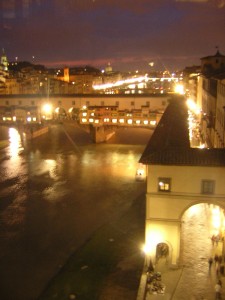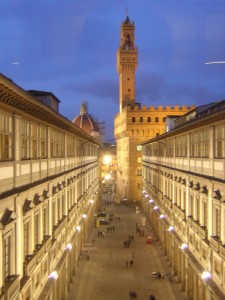Machiavelli I – S.P.Q.F. (Begins Machiavelli Series)
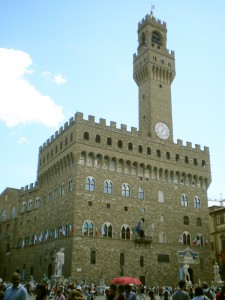
My year in Florence has flown by, leaving me to face up to a life without battlements and medieval towers, without Botticelli and Verrocchio, without church bells to inform me when it’s noon, or 7 am, or 6 am, or 6:12 am (why?), without squash blossoms as a pizza topping, without good gelato within easy reach, and without looking out my window and realizing that the humungous dome of the cathedral is still shockingly humungous whenever I see it, and the facade so beautiful that it hasn’t started to feel real, not even after so long. Among the cravings I have felt for Florence in the first weeks of separation—cravings for watermelon granita, Cellini’s statue of Perseus and long walks between historic facades—the most acute has been for a view: the view up from the square into the little office in the Palazzo Vecchio where Machiavelli worked.
You may have noticed that I appended the tag “S.P.Q.F.” to every post this year. It has been my title for the year-in-Florence chapter of my activities, and in explaining why I find it such a fitting title I am at last going to answer formally here one of my favorite questions. It’s my habit in Florence to strike up conversation with random passing tourists, and as one thing leads to another (and often to pizza, gelato and the Uffizi) there are various questions I am often asked by people who discover they have a chance to talk to a real live Renaissance scholar. “Why did they make all this art?” is a common one. Also “Does the Vatican Library really look like it does in Dan Brown?” (that’ll be another day’s post), but the one which I am always happiest to get, and which I get delightfully often, is “So, why is Machiavelli really so important?” Now, I read The Prince in school, and remembered ideas including the stock “It is better to be feared than loved,” and “The ends justify the means,” but I also remember having no idea then why Machiavelli was a big name. I’m pretty sure my teacher didn’t really know either. In fact, most introductions to the works of Machiavelli that I’ve read didn’t even manage to make it clear. After ten years as a specialist in the Renaissance, I think I can finally explain why.
I cannot, however, explain everything at once. There’s too much to do it well. I will therefore divide it into three parts. Doing so is easy, because Machiavelli made two big, big breakthroughs. If I treat each in turn, with the proper historical context, I think I can make Machiavelli make sense.
- Machiavelli, founder of Modern Political Science and History.
- Machiavelli, founder of Utilitarianism/Consequentialist ethics.
The latter issue is where Machiavelli picks up such titles as Arch-Heretic, Anti-Pope, and Destroyer of Italy (also father of modern cultural analysis and religious studies). The former, however, is even more universal in its penetration into modern thought.
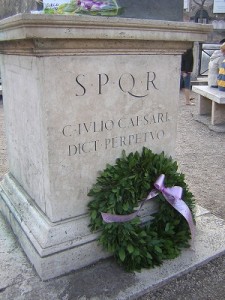
Many are familiar with S.P.Q.R. (Senatus Populus que Romanus, i.e. the Senate and the People of Rome). This is the symbol and slogan of the city of Rome, and has been from the ancient Republic to today. One finds it on stone inscriptions, modern storm drains, grand coats of arms, sun-bleached baseball caps, tattoos, always as a symbol of pride in the continuity of the Roman people and their republican heart. For we who learn in middle school to place the fall of the Empire in 410 or 434 AD, and the end of the Roman Republic in 27 BC when Augustus became Emperor, it is hard to remember that the Senate and other offices of the Republic continued to exist. They existed under the Caesars. They existed in strange forms under the Goths who replaced the Caesars. There were some struggles in the 550s, but even after the 600s, when we think the political Senate probably ceased to exist, there were still important families referred to as Senators. New senates were periodically reintroduced (the Republic had a big moment in 1144) but even when there wasn’t a Senate, the popes who ruled Medieval and Renaissance Rome had to maintain a careful, wary balance with the Roman mob and the powerful Roman “senatorial” families, who sincerely believed they were descendants of ancient Roman senators. Thus, while S.P.Q.R. is the symbol of the Roman Republic, in a long-term sense it represents more Roman pride in self-government as an idea, whether that self-government operates as it did in the Republic through popular election of Senators from among the members of a select group of oligarchical ruling families, or as it did in much of Christian Rome; by securing minimal concessions from the popes through the ability of the Roman city populace and its wealthy lead families to riot, prevent riots, stop invaders, aid invaders, supply funds, refuse to supply funds, and in crisis moments generally be of great aid or great harm to the pontiff and his forces.
S.P.Q.R. represents civic pride so deeply that, counter-intuitive as it may seem, many other cities picked it up. London occasionally used to use S.P.Q.L., and one may read S.P.Q.S. on the shield above the door of the civic museum of the miniscule one-gelateria town of Sassoferrato. And so, I have chosen S.P.Q.F. as the slogan for my year in Florence. “But none of those cities have a Senate!” you may object. Neither, sometimes, did Rome, but it always had a Senate in spirit, and so did these other cities who, by adopting S.P.Q.*. proclaim that they love their city as much as Romans love Rome.
Petrarch, father of Renaissance humanism, desperately wanted Florentines to love Florence as much as Romans had loved Rome, the ancient Romans that he read about in mangled copies of copies of copies of the beautiful, alien Latin of a lost world. He read of the Consul Lucius Junius Brutus who ordered the execution of his own sons when they conspired against the Republic, while at the same time Florence was hiring noblemen from other cities to enforce her laws, and equipping these mercenary magistrates with a private fortress within the city walls (the Bargello) so they could endure siege when they arrested members of powerful Florentine families, and the families attacked to try to liberate their own. He read of the golden peace forged by Augustus, even as rival Florentine families used meaningless factions like the Guelphs and Ghibbelines as excuses to make bloody civil war within the city’s walls. He read of hero after hero who sacrificed their lives for Rome, as families took turns coming to power and persecuting or exiling their rivals, mingling grudges with politics in wholly selfish ways. Petrarch himself grew up in France because his father had been exiled in the squabbles between Black Guelphs and White Guelphs, and had gone to seek work in Avignon, where the French king had carried off the papacy because Rome and her neighbors were too weak to defend the capital from what had once been her own colony. He was born in exile, as he put it, an exile in time as well as place, for his home should have been, not fractious Italy, but glorious Rome, and his neighbors Seneca and Cicero.
The solution Petrarch proposed to what he saw as the fallen state of “my Italy” was to reconstruct the education of the ancient Romans. If the next generation of Florentine and, more broadly, Italian leaders grew up reading Cicero and Caesar, the Roman blood within them might become noble again, and they too might be more loyal to the people than to their families, love Truth more than power, and in short love their cities as the Romans loved Rome. Such men would, he hoped, be brave and loyal in strengthening and defending their homelands. Rome started as one city, and did not make itself master of the world without citizens willing to die for it.
(Yes, I am going to talk about Machiavelli, and I hope you see here that the fundamental mistake most introductions to Machiavelli make is that they start by talking about Machiavelli. Context is everything.)
“Petrarch says we can become as great as the ancients by studying their ways! Let’s do it!” Petrarch’s call went out and, with amazing speed, Italy listened. Desperate, war-torn city states like Florence who hungered for stability poured money into assembling the libraries which might make the next generation more reliable. Wealthy families who wanted their sons to be princely and charismatic like Caesar had them read what Caesar read. Italy’s numerous tyrants and newly-risen, not-at-all-legitimate dukes and counts filled their courts and houses and public self-presentation with Roman objects and images, to equate themselves with the authority, stability, competence and legitimacy of the Emperors. No one took this plan more to heart than Petrarch’s beloved Florentine republic, and, within it, the Medici, who crammed their palaces with classical and neoclassical art, and with the education of Lorenzo succeeded in producing a classically-educated scion who was more princely than princes.
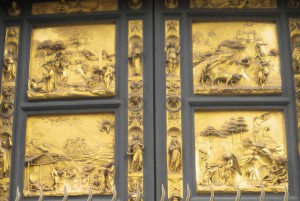 And we’re off! Fountains! Busts! Triumphal arches! Equestrian bronzes! Romanesque loggias! Linear perspective! Mythological frescoes! Confusing carnival floats covered with allegorical ladies! Latin! Greek! Plato! Galen! Geometry! Rhetoric! Navigation! Printing! Libraries! Anatomy! Grottoes! Syncretism! Philosopher princes! Ninja Turtles! Neo-Stoic political maxims! Neo-Platonic love letters! Lyre-playing! Theurgic soul projection! Symposia hosted by Lorenzo de Medici where philosophers and theologians lounge about discussing theodicy and the nature of the Highest Good! All that stuff that makes the Renaissance so exciting!
And we’re off! Fountains! Busts! Triumphal arches! Equestrian bronzes! Romanesque loggias! Linear perspective! Mythological frescoes! Confusing carnival floats covered with allegorical ladies! Latin! Greek! Plato! Galen! Geometry! Rhetoric! Navigation! Printing! Libraries! Anatomy! Grottoes! Syncretism! Philosopher princes! Ninja Turtles! Neo-Stoic political maxims! Neo-Platonic love letters! Lyre-playing! Theurgic soul projection! Symposia hosted by Lorenzo de Medici where philosophers and theologians lounge about discussing theodicy and the nature of the Highest Good! All that stuff that makes the Renaissance so exciting!
In 1506 the Florentine Captain General Ercole Bentivoglio wrote to Machiavelli encouraging him to finish his aborted History of Florence because, in his words, “without a good history of these times, future generations will never believe how bad it was, and they will never forgive us for losing so much so quickly.”
Yes, this is the same Renaissance.
The flowering peak, as we see it, when Raphael and Michelangelo and Leonardo were working away, when the libraries were multiplying, and cathedrals rising which are still too stunning for the modern eye to believe when we stand in front of them, this was such a dark time to be alive that the primary subject of Machiavelli’s correspondence, just like the subject of Petrarch’s 150 years before, was the desperate struggle for survival.
Let us zoom both in and out, for a moment, and take stock of Florence’s situation in the world of Europe as the 1400s close. Florence is one of the five most populous cities in the European world, well… four, now that Constantinople has fallen (1453). Its population is near 100,000, and it rules a large area of farmland and countryside and several smaller nearby cities. It is also one of the wealthiest cities in the world, thanks to the vast private fortunes of its numerous wealthy merchants and banking families, of whom the Medici are but the wealthiest of many. We live in an era before standing armies, but Florence has a force of soldiers for enforcing law, and some modest mercenary armies which it hires.
Who else exists? There is France, the most populous kingdom in Europe, with vast wealth, a population of millions to sustain enormous armies, and Europe’s most powerful king. There are the Spanish kingdoms of Aragon and Castille, with vast naval resources, entering the final stages of merging their crowns into what will soon be Spain. There is the Holy Roman Empire, a complex confederation of semi-independent sub-kingdoms under an elected-but-traditionally-hereditary Emperor who is also ruler of Italy in name, though not in practical terms. There are other kingdoms with ambitious kings and powerful navies: England, Portugal. There is the mysterious and terrifying Ottoman Empire to the East which has made great inroads in the Balkans and Africa. There are the two peculiar and impregnable powers of Europe: Venice with its modest land empire but huge sea empire of port cities and coastal fortresses which pepper the Eastern Mediterranean much farther out than any other Christian force dares go; and the Swiss who live untouchable between their Alps and base their economy almost entirely on renting out their armies as mercenaries to whoever has the funds to hire what everyone acknowledges are the finest troops on the continent. With the sole exception of the Swiss, all these powers want more territory, and there is no territory juicier than Italy, with its fat, rich little citystates, booming with industry, glittering with banker’s gold, situated on rich agricultural fields, and with tiny, tiny populations capable of mustering only tiny, tiny armies. The southern half of Italy has already fallen to the French… no wait, the Spanish… no, it’s the French again… no, the Spanish. The north is next.
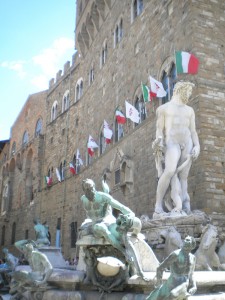 That’s how bad it was. That’s why there was such a great flourishing of art and literature and philosophy and invention; because in desperate times people try desperate things to stay alive, and if art, philosophy and cunning are one’s only weapons, one hones one’s art, philosophy and cunning. And that’s why we needed a good historian.
That’s how bad it was. That’s why there was such a great flourishing of art and literature and philosophy and invention; because in desperate times people try desperate things to stay alive, and if art, philosophy and cunning are one’s only weapons, one hones one’s art, philosophy and cunning. And that’s why we needed a good historian.
1492. Lorenzo de Medici, the philosopher quasi-prince, dies, leaving the Medici family resources and effective rule of Florence to his 20-year-old son Piero. Roderigo Borgia is elected Pope Alexander VI, handing control of Rome to the Borgias. Also, some guy called Christopher finds some continent somewhere.
1494. The French invade Italy. This can be partly blamed on Borgias, partly on members of the Sforza family squabbling with each other over who will rule Milan, but France, and every other major power in Europe, had been hungry for Northern Italy for ages.
Now is the moment for young Piero, Lorenzo’s successor, educated by the greatest humanists in the world with the reading list that produced Brutus and Cicero, to marshal his family’s wealth and stand bravely before the enemy. Piero… runs away. Not a high point for Petrarch’s idea of instilling virtue and good leadership through classical education.
In the absence of the Medici, Florence’s republic went through some twists (i.e. Savonarola) and managed to persuade the French not to destroy them through sheer force of argument (again Savonarola), and in 1498 (by removing Savonarola) reverted again to mostly actually being the republic it had consistently insisted it still was all this time. S.P.Q.F.
This, now, was Machiavelli’s job when he worked in that little office in the Palazzo Vecchio:
- Goal: Prevent Florence from being conquered by any of 10+ different incredibly enormous foreign powers.
- Resources: 100 bags of gold, 4 sheep, 1 wood, lots of books and a bust of Caesar.
- Go!
“Desperation” does not begin to cover it. There are armies rampaging through Italy expelling dukes and redrawing borders. Machiavelli is an educated man. He has read all the ancients, all the histories, all the moral maxims and manuals of government. He negotiates. He makes alliances. He plays the charisma card. We’re Florence: we have all the art, all the artists, all the books; you don’t want to destroy us, you want to be our ally. When that fails, there is the bribery card. We can’t defeat you, France, but we can give you 100 bags of gold to use to fund your wars against other people if you attack them instead. Machiavelli negotiates alliances with France. He negotiates alliances with Cesare Borgia. He negotiates anything he has to. He tries to create an army of citizen soldiers who will not, as mercenaries do, abandon the field when things are against them because they have no incentive to die for someone else as citizens do for their families and fatherland (the Senate and the People of Florence!)
1503. The Borgias fall (a delightful story, for another day). The bellicose and crafty Pope Julius II comes to power.
1508. The Italian territories destabilized by the Borgias are ripe for conquest. Everyone in Europe wants to go to war with everyone else and Italy will be the biggest battlefield. Machaivelli’s job now is to figure out who to ally with, and who to bribe. If he can’t predict the sides there’s no way to know where Florence should commit its precious resources. How will it fall out? Will Tudor claims on the French throne drive England to ally with Spain against France? Or will French and Spanish rival claims to Southern Italy lead France to recruit England against the houses of Aragon and Habsburg? Will the Holy Roman Emperor try to seize Milan from the French? Will the Ottomans ally with France to seize and divide the Spanish holdings in the Mediterranean? Will the Swiss finally wake up and notice that they have all the best armies in Europe and could conquer whatever the heck they wanted if they tried? (Seriously, Machiavelli spends a lot of time worrying about this possibility.) All the ambassadors from the great kingdoms and empires meet, and Machiavelli spends frantic months exchanging letters with colleagues evaluating the psychology of every prince, what each has to gain, to lose, to prove. He comes up with several probable scenarios and begins preparations. At last a courier rushes in with the news. The day has come. The alliance has formed. It is: everyone joins forces to attack Venice.
O_O ????????
Conclusion: must invent Modern Political Science.
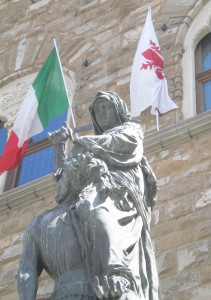
I am being only slightly facetious. The War of the League of Cambrai is the least comprehensible war I’ve ever studied. Everyone switches sides at least twice, and what begins with the pope calling on everyone to attack Venice ends with Venice defending the pope against everyone. Between this and the equally bizarre and unpredictable events which had dominated the era of the Borgia papacy and pope Julius’ rise to power (another day, I promise!) Machiavelli was left with the conclusion that the current methods they had for thinking about history and politics were simply not sufficient.
Machiavelli did not, however, stop immediately and start working on the grand treatises and new historical method he would hand down to posterity. He had a job to do, and wasn’t concerned with posterity—or rather he was, but with a very specific posterity: the posterity of Florence. S.P.Q.F.
1512. The Medici family returns, armed with new allies and mercenaries, and takes Florence by force. The Pallazzo Vecchio, seat of the Signoria, heart of the city, is converted into the Ducal palace. Machiavelli is expelled from government and, after a little while, is (falsely) accused of plotting against the Medici, arrested, tortured and banished.
Now, after the grand and fast-paced life of high politics, after being ambassador to France, after walking with princes, Machiavelli finds himself at a farm doing nothing. He describes in a letter his weary days, taking long walks through fields and catching larks, retiring to a pub to listen to the petty babble of his rustic neighbors. At the end of a wasted day, he says, he returns each evening to his little cottage, there strips away the dirt and ragged day clothes of his new existence, and puts on the finery of court. Thus attired, ready to negotiate with kings and popes, he enters his library, there to spend the evenings in commerce with the ancients.
And he starts writing his “little book on princes.”
Now, everyone who’s anyone is banished from Florence at some point. Dante, Petrarch, Cosimo de Medici, Benvenuto Cellini like five times… When one is banished, one is often banished to some spot in the countryside outside Florence, which is what happened in this case. The terms, generally, are that if you’re good and stay there then they’ll think about someday calling you back, but if you run off to some other city they make your banishment a bit more permanent. Machiavelli is expected to run off. He’s a talented and experienced political agent, a great scholar, author and playwright. He could get a job in Rome for the pope or a Cardinal, in Naples, in Paris, in a dozen Italian citystates, in the Empire. He doesn’t. He doesn’t even try.
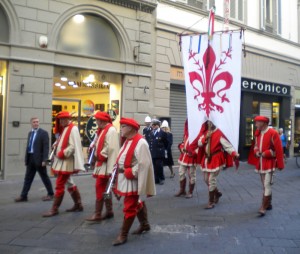 Machiavelli only works for Florence. S.P.Q.F.
Machiavelli only works for Florence. S.P.Q.F.
What he does do is everything in his power to get the Medici to hire him. “The Medici? Didn’t they destroy his precious republic? Didn’t they expel him? Didn’t they torture him?” Yes, but that doesn’t matter. What matters is that they rule Florence, and whoever rules Florence must be strong. History shows that, when there is a regime change, there is civil war and people die. When Florence has a regime change, Florentines die, and non-Florentines have a good chance of stepping in for conquest. The Prince is a manual for staying in power. Machiavelli writes it for the Medici, hoping it will secure him a job so he can get back where he should be, working for Florence’s safety from the inside. But it also explains his conclusions from all this dark experience.
History should be studied, NOT as a series of moral maxims intended to rear good statesmen by simply saturating them with stories about past good rulers and hoping they become virtuous by osmosis. History should be studied for what it tells us about the background and origins of our present, and past events should be analyzed as a set of examples, to be compared to present circumstances to help plan actions and predict their consequences. Only this way can disasters like the Borgia papacy, the French invasion and the War of the League of Cambrai be anticipated and avoided. What worked? What didn’t? What special characteristics of different times and places have led to success and failure?
This is modern Political Science. It is how we all think about history now, and the way it is approached in every classroom. We are, in this sense, all Machiavellian.
Of course, that is not what the word Machiavellian means. The new system of ethics Machiavelli introduces in his manual to keep the Medici in power is deservedly recognized as one of the most radical, dangerous and potentially destructive moves in the history of philosophy, and one of the most far-reaching. We are used to the trite summary “the end justifies the means,” and all the terrible, villanous things which that phrase has justified. But Machiavelli’s formula is not in any way villanous, nor was he. I will need another day to fully explain what that phrase means, but in a micro-summary, yes, Machiavelli did argue that the end justifies the means, and yes, he did mean it, but in his formulation “the end” was limited to one and only one very specific thing: the survival of the people under a government’s protection. Or even more specifically, the survival of Florence. That cathedral, those lively alleyways, those sculptures, that poetry, that philosophy, that ambition. S.P.Q.F.
Do you ever play the game where you imagine sending a message back in time to some historical figure to tell him/her one thing you really, really wish they could have known? To tell Galileo everyone agrees that he was right; to tell Schwarzschild that we’ve found Black Holes; to tell Socrates we still have Socratic dialogs even after 2,300 years? I used to find it hard to figure out what to tell Machiavelli. That his name became a synonym for evil across the world? That the Florentine republic never returned? That children in unimagined continents read his works in order to understand the minds of tyrants? That his ideas are now central to the statecraft of a hundred nations which, to him, do not yet even exist?
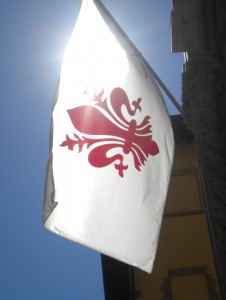 But now I know what I would say:
But now I know what I would say:
“Florence is on the UNESCO international list of places so precious to all the human race that all the powers of the Earth have agreed never to attack or harm them, and to protect them with all the resources at our command.”
He would cry. I know he would. It’s the only thing he ever really wanted. When I think about that, how much it would mean to him, and pass his window in the Pallazzo Vecchio which he spent so many years desperate to return to, I cry too.
Machiavelli definitely loved Florence as much as the Romans loved Rome, and worked to protect it as much as Brutus or Cicero. Florence also deserved to be loved that much. It deserves its S.P.Q.F. I’ve had, not just this year, but several earlier opportunities to get to know Florence in person, and even more years to read deeply into Florentine history and really understand all the invaluable contributions this city has made to the world. I could never call myself a Florentine, but I do believe I am now someone who understands why Florence deserves to be loved that much by her people, why Florence deserved Machiavelli, and his efforts, and all the efforts of the other great figures—Dante, Petrarch, Ficino, Bruni, Brunelleschi, Cosimo and Lorenzo de Medici—who worked so hard to save it—through art, philosophy and guile—from the destruction that always loomed. I know why it deserves UNESCO’s recognition too. It makes it a hard home to leave.
See next, Machiavelli I.5, Thoughts on Presenting this Style of History, then Machiavelli II: the Three Branches of Ethics

